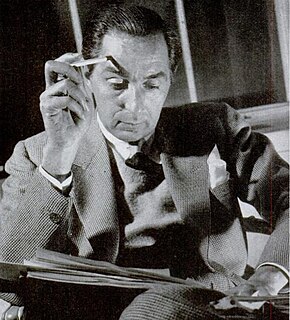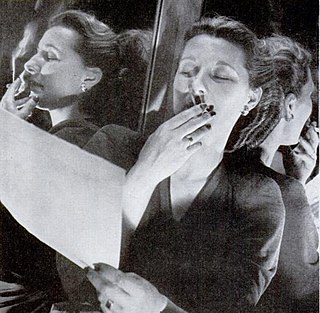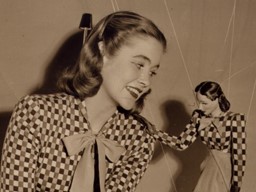Related Research Articles
Eleanor Lambert Berkson was an American fashion publicist. She was instrumental in increasing the international prominence of the American fashion industry and in the emergence of New York City as a major fashion capital. Lambert was the founder of New York Fashion Week, the Council of Fashion Designers of America, the Met Gala, and the International Best Dressed List.
The Coty American Fashion Critics' Awards were created in 1942 by the cosmetics and perfume company Coty, Inc. to promote and celebrate American fashion, and encourage design during the Second World War. In 1985, the Coty Awards were discontinued with the last presentation of the awards in September 1984; the CFDA Awards fulfill a similar role. It was casually referred to as "fashion's Oscars" because it once held great importance within the fashion industry and the award ceremonies were glitzy galas.

Kenneth Jay Lane was an American costume jewelry designer.

Norman David Levinson known professionally as Norman Norell, was an American fashion designer famed for his elegant gowns, suits, and tailored silhouettes. His designs for the Traina-Norell and Norell fashion houses became famous for their detailing, simple, timeless designs, and tailored construction. By the mid-twentieth century Norell dominated the American fashion industry and in 1968 he became the first American fashion designer to launch his own brand of perfume.
Susan Bennis/Warren Edwards was a successful New York-based shoe company founded in 1972 by Susan Bennis and Warren Edwards. It dissolved in 1997.
Bonnie Cashin was an American fashion designer. Considered to be pioneer in the design of American sportswear, she created innovative, uncomplicated clothing that catered to modern, independent woman of the post-war era through to her retirement from the fashion world in 1985.

Alexis Kirk was an American jewelry designer who also designed clothing and fashion accessories.

Clare Potter was a fashion designer who was born in Jersey City, New Jersey in 1903. In the 1930s she was one of the first American fashion designers to be promoted as an individual design talent. Working under her elided name Clarepotter, she has been credited as one of the inventors of American sportswear. Based in Manhattan, she continued designing through the 1940s and 1950s. Her clothes were renowned for being elegant, but easy-to-wear and relaxed, and for their distinctive use of colour. She founded a ready-to-wear fashion company in Manhattan named Timbertop in 1948, and in the 1960s she also established a wholesale company to manufacture fashions. Potter was one of the 17 women gathered together by Edna Woolman Chase, editor-in-chief of Vogue to form the Fashion Group International, Inc., in 1928.
Helen Lee Caldwell was an American fashion designer of children's clothes. She founded her own label, Designs by Helen Lee Inc., in 1955.

Anne Fogarty was an American fashion designer, active 1940–1980, who was noted for her understated, ladylike designs that were accessible to American women on a limited income. She started out as a model in New York in 1939, working for Harvey Berin on Seventh Avenue, before studying fashion design. She eventually secured a full-time design job in 1948, and became well-known for full-skirted designs with fitted bodices, inspired by Dior's New Look.
Eustațiu Stoenescu was a Romanian painter principally known for his portraiture. Eustatiu Stoenescu family originated from Oltenia in Romania. His father was a senator and his mother Mathilda was born in Brittany. Stoenescu met the French painter Leopold Durangel in 1889. He moved to Paris in 1900, with his friend Nicolas Titulescu. Stoenescu was, early on, inspired by the work of Jean-Paul Laurens with whom he studied. His first exhibition took place in 1905 at the Salon officiel de Paris and the same year in Craiova. He was immediately successful and had the opportunity to meet prestigious artists such as Auguste Rodin, Antoine Bourdelle, Henri Harpignies and Charles Cottet. By 1930 he was considered in French art circles to be the greatest living Romanian painter at the time. He was great portraitist not only capable of showing physical resemblance of the model but also the psychological dimension. He went many times in Brittany where he painted landscapes especially in Loctudy. He was a friend of the sculptor Constantin Brâncuși, who made a (lost) portrait bust of Stoenescu's son Daniel Eustațiu Stoenescu. Daniel went on to become a successful, Coty Award winning designer of inventive costume jewellery who, with Steven Brody, founded the Cadoro jewelry company in Manhattan.
Bill Smith is an American fashion and jewelry designer who was the first black recipient of a Coty Award for his designs. He has designed for a number of companies, including costume jewelry for Coro and Richelieu, leather goods for Mark Cross, and furs for Ben Kahn, along with designing jewelry for Cartier.
Marty Ruza of "Ruza Creations"/"Elegant Belts" was an American designer of leather fashion accessories who won a Coty Award for jewelry design in 1970. He was described by the fashion journalist Eleanor Lambert as the "leader of the fringed leather and beads school".
Clifton 'Cliff' Nicholson is an American sculptor and jewelry designer.
Up Tied was an American textile house specialising in tie-dyed fabrics founded in 1968 by the husband and wife team Will and Eileen Richardson and Eileen's brother, Tom Pendergast. They won a special Coty Award for "major creativity in fabrics" in 1970.
Kieselstein-Cord is a brand founded by American designer, artist, and photographer Barry Kieselstein-Cord in 1972 in Manhattan, New York. Products include jewelry, silver jewelry, belt buckles, bronze statuary, leather goods including handbags, eyewear, home furnishings, and accessories.

Thomas Franklin Brigance, professionally known as Tom Brigance, was a Texan-born New York-based fashion designer noted for his work in sportswear in the 1930s, 1940s and 1950s. As a house designer for Lord & Taylor, Brigance was best known for bathing costumes and play clothes, and for his clever use of flattering details such as pleats and darts. During the 1930s Brigance was a rare example of a male working in the female-dominated world of American sportswear design. In the late 1930s, he was regularly mentioned alongside Clare Potter as a leading name in mid-range priced sportswear. Like Potter, Brigance was skilled at designing smart, fashionable clothing which could easily be mass-produced, making his work attractive to manufacturers as well as to customers.

Emily Wilkens (1917-2000) was an American fashion designer specialising in childrenswear. She won both the Neiman Marcus Fashion Award and the Coty Award for her work, which was considered groundbreaking for properly taking note of the requirements of teenage dressing, and not simply offering miniature grown-up garments. She was also an author, writing a number of books on self care and style, and during the late 1960s and early 1970s, became a beauty journalist, writing an advice column. She died in 2000.
Sydney Wragge (1908–1978) was an American fashion designer active during the 1940s, 1950s and 1960s. Working as B.H. Wragge, he was particularly renowned for his American sportswear, with the historian Caroline Rennolds Milbank declaring him the leader in mix-and-match separates and interchangeable wardrobe design.
Victor Joris (1929–2013) was an American fashion designer and fashion illustrator. He was active between 1945 until the 1970s.
References
- 1 2 "Cadoro in the collection of the Met". Metropolitan Museum of Art. Retrieved 26 November 2012.
- 1 2 3 4 "Obituary: S. Steven Brody, 75, Designer of Jewelry". The New York Times. 1 January 1995. Retrieved 26 November 2012.
- 1 2 3 "Ring Stephen (sic) Brody (American, born 1926) and Dan Stoenescu (American, born 1921)". MoMA. Retrieved 26 November 2012.
- 1 2 3 Lambert, Eleanor (1976). World of fashion : people, places, resources . New York: R.R. Bowker Co. pp. 213. ISBN 0835206270.
- 1 2 Hughes, Alice (24 August 1966). "A Woman's New York". The Reading Eagle. Retrieved 26 November 2012.
- 1 2 Nemy, Enid (17 February 1969). "No Matter What You Call It, Body Jewelry Is Made to Top Nudity" (PDF). Utica Observer Dispatch. Retrieved 26 November 2012.
- ↑ McDowell, Colin (1984). McDowell's Directory of Twentieth Century Fashion. Frederick Muller. pp. 299–301. ISBN 0-584-11070-7.
- ↑ Banik, Sheila (July 1981). "Bill Smith: The Maverick". Black Enterprise: 36.
- ↑ Lambert, Eleanor (19 September 1970). "Ethnic Theme Monopolises Front Seat in Fashion". The News and Courier. Retrieved 29 November 2012.